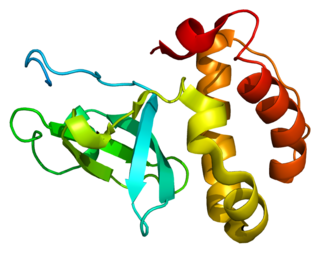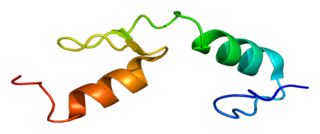Zinc finger protein 238 (also known as RP58 or ZBTB18) is a zinc finger containing transcription factor that in humans is encoded by the ZNF238 gene. [5] [6]
Zinc finger protein 238 (also known as RP58 or ZBTB18) is a zinc finger containing transcription factor that in humans is encoded by the ZNF238 gene. [5] [6]
ZNF238 is a gene that plays a major role in the "promotion of ordered and correctly timed neurogenesis leading to proper layer formation and cortical growth." [7] The loss of ZNF238 has been observed to cause microcephaly, agenesis of the corpus callosum, malformation of layers in the cerebral cortex, and cerebellar hypoplasia. [7] Additionally, its absence can cause a decrease in Ngn2 and Neurod1 (in progenitor cells, and an increase thereof in mutant neurons), with the result of less progenitor cells and an increase in neuronal differentiation and glial cell growth. [7] ZNF238 also regulates repressed genes that, if left unchecked, can lead to glioma progression. Furthermore, an absence of ZNF238 results in upregulation of the epithelial-mesenchymal transition process.
In tumors such as medulloblastomas, the loss of ZNF238 can disorganize the tumor's cellular divisional processes, resulting in a cellularly diverse neoplasm. This new diversity has been observed to increase the invasiveness of the tumor, yielding proliferation into more areas of the brain than before the loss of ZNF238.
C2H2-type zinc finger proteins, such as ZNF238, act on the molecular level as transcriptional activators or repressors and are involved in chromatin assembly. [8]

EGR-1 also known as ZNF268 or NGFI-A is a protein that in humans is encoded by the EGR1 gene.

DNA (cytosine-5)-methyltransferase 3 beta, is an enzyme that in humans in encoded by the DNMT3B gene. Mutation in this gene are associated with immunodeficiency, centromere instability and facial anomalies syndrome.

DNA (cytosine-5)-methyltransferase 3A is an enzyme that catalyzes the transfer of methyl groups to specific CpG structures in DNA, a process called DNA methylation. The enzyme is encoded in humans by the DNMT3A gene.

RE1-Silencing Transcription factor (REST), also known as Neuron-Restrictive Silencer Factor (NRSF), is a protein which in humans is encoded by the REST gene, and acts as a transcriptional repressor. REST is expressly involved in the repression of neural genes in non-neuronal cells. Many genetic disorders have been tied to alterations in the REST expression pattern, including colon and small-cell lung carcinomas found with truncated versions of REST. In addition to these cancers, defects in REST have also been attributed a role in Huntington Disease, neuroblastomas, and the effects of epileptic seizures and ischemia.

DNA (cytosine-5)-methyltransferase 3-like is an enzyme that in humans is encoded by the DNMT3L gene.

Zinc finger protein 40 is a protein that in humans is encoded by the HIVEP1 gene.

Zinc finger protein 350 is a protein that in humans is encoded by the ZNF350 gene.

Zinc fingers and homeoboxes protein 3 is a protein that in humans is encoded by the ZHX3 gene.

Juxtaposed with another zinc finger protein 1 (JAZF1) also known as TAK1-interacting protein 27 (TIP27) or zinc finger protein 802 (ZNF802) is a protein that in humans is encoded by the JAZF1 gene. Variants are associated with an increased risk of prostate cancer, an increased risk of type 2 diabetes, and an increased height.

Zinc finger protein 10 is a protein that in humans is encoded by the ZNF10 gene.

Zinc finger protein 274 is a protein that in humans is encoded by the ZNF274 gene.

Zinc finger and BTB domain-containing protein 32 is a protein that in humans is encoded by the 1960 bp ZBTB32 gene. The 52 kDa protein is a transcriptional repressor and the gene is expressed in T and B cells upon activation, but also significantly in testis cells. It is a member of the Poxviruses and Zinc-finger (POZ) and Krüppel (POK) family of proteins, and was identified in multiple screens involving either immune cell tumorigenesis or immune cell development.

Transcription factor HIVEP2 is a protein that in humans is encoded by the HIVEP2 gene.

Zinc fingers and homeoboxes protein 2 is a protein that in humans is encoded by the ZHX2 gene.

Transcription factor HIVEP3 is a protein that in humans is encoded by the HIVEP3 gene.

Zinc finger protein 160 is a protein that, in humans, is encoded by the ZNF160 gene.

Zinc finger protein 804A is a protein that in humans is encoded by the ZNF804A gene. The human gene maps to chromosome 2 q32.1 and consists of 4 exons that code for a protein of 1210 amino acids.

Zinc finger protein 516 is a protein that in humans is encoded by the ZNF516 gene.

Zinc finger protein 226 is a protein that in humans is encoded by the ZNF226 gene.

Zinc Finger Protein 548 (ZNF548) is a human protein encoded by the ZNF548 gene which is located on chromosome 19. It is found in the nucleus and is hypothesized to play a role in the regulation of transcription by RNA Polymerase II. It belongs to the Krüppel C2H2-type zinc-finger protein family as it contains many zinc-finger repeats.
This article incorporates text from the United States National Library of Medicine, which is in the public domain.